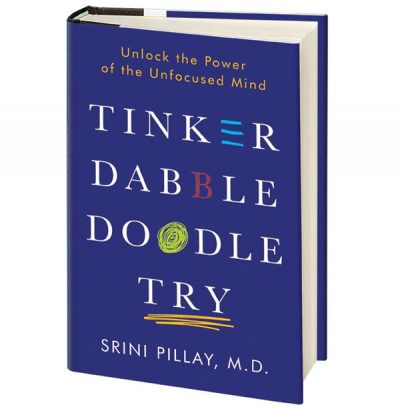The Secret Key To Multitasking Isn’t What You’d Think
By Srini Pillay
June 12, 2017 • Fact checked by Dumb Little Man

Think back to your last firm handshake.
How much of your attention did this activity demand? Did you need to stop talking and devote your entire focus just to make sure you successfully grasped the other person's hand?
Probably not as your brain is wired for parallel processing. Its seeing and guiding pathways allowed you to continue speaking while simultaneously doing a handshake.
Unfortunately, parallel processing doesn’t always come naturally to us.
For example, think back to the last time you found yourself listening to a conference call while responding to an urgent email. In all likelihood, that situation probably led to multitasking misery. Your heart rate and blood pressure spiked as you tossed your “undivided” attention back and forth. And, at the end of the day, neither task was executed to its full potential.
If this negative outcome sounds familiar to you, don’t worry. You’re not alone.
According to University of Utah researchers, just 2.5% of the population can be considered “supertaskers”. They are the people who can easily bounce between tasks without sacrificing quality.
In our professional lives, we would all benefit from becoming graceful jugglers who never need to focus on one ball at a time. In my book “Tinker, Dabble, Doodle, Try,” I explained how — through brain-based exercises that stimulate the default mode network (DMN), the brain’s “unfocus” circuit — we can train ourselves to become just that.
Here are three unfocus strategies that can help you develop parallel processing skills. They can make multitasking as easy as a handshake.
Dare to daydream
Throughout our lives, we’re told that daydreaming is a guilty, unproductive habit that distracts us from reality. On the contrary, however, science proves that daydreaming can actually be productive when it’s planned ahead of time and paired with a laid-back activity, like doodling or knitting.
This seemingly taboo practice played a major role in helping me leverage my passions for music, psychiatry, neuroscience and executive coaching into a business venture.
See Also: A Guide To Guilt-Free Daydreaming
Specifically, positive constructive daydreaming (PCD) is a technique that trains the brain to make quick associations and become more creative. To engage in PCD, pencil in a 10-minute period every day to find a quiet spot, pull your attention away from the computer screen and wander into your head.
Start the process by visualizing a playful and wish-laden image. It could be something relevant to the tasks currently on your plate. Then, allow this image to guide you on a productive daydreaming journey that helps you better predict the future.
According to Jerome Singer, the “father of daydreaming”, PCD is a reliable way to turn your brain into a fluent integration and association machine. This is a hallmark of parallel processing and a key ingredient of multitasking.
Get physical
A little bit of stress can actually go a long way when it comes to activating the DMN and unlocking your multitasking skills. However, it’s imperative to learn how to control this stress. Otherwise, your unfocus circuit can get stuck in the “on” position and you won’t be able to actually buckle down once it’s time to tackle tasks.
Brief periods of exercise- whether jogging or mock wrestling with your kids- offer a great way to reduce stress, bring more order to your DMN and boost your multitasking abilities. Rough-and-tumble play relieves the brain of the burden of focused attention while improving self-control. It switches your brain to autopilot and leaves you available to sense and respond.
This is exactly why I make a concerted effort to regularly incorporate physical activity into my life. I’m no Roger Federer, but I’ve found that my mind wanders toward innovative solutions when I play tennis. Through exercise, I’ve learned that physical fitness leads to mental prowess.

Provide feedback early and often
Motoring through your tasks without assessing your progress is the least effective thing you can do. Your brain doesn’t automatically update information and gauge results as you go along. You need to consciously provide it with this feedback and positive reinforcement. Otherwise, you’ll quickly find yourself feeling stressed and overwhelmed.
Feedback can be divided into two primary categories: local and global.
Local feedback pertains to specific tasks (e.g., “That conference call went well.”), while global feedback refers to the task list as a whole (e.g., “On average, everything seemed to have gone well.”). When it comes to multitasking, gravitate toward frequent local feedback. Check in with yourself after each task, ask yourself how it went and move forward while making any necessary adjustments.
Multitasking is a challenge to our brains. But, with some training, it can be an invaluable skill that goes beyond handshakes. Activate your DMN and familiarize yourself with its inner workings. The resulting enhanced brain function will allow for connections, coordination and smooth execution in times when you need to juggle tasks.
Srini Pillay
Srini Pillay, M.D., is the CEO of NeuroBusiness Group and the award-winning author of “Tinker Dabble Doodle Try: Unlock the Power of the Unfocused Mind,” available for preorder wherever books are sold; “Life Unlocked: 7 Revolutionary Lessons to Overcome Fear;” and “Your Brain and Business: The Neuroscience of Great Leaders.” He is also Assistant Professor of Psychiatry (Part-time) at Harvard Medical School and teaches in the Executive Education Program at Harvard Business School.


